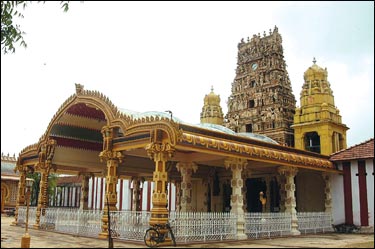Dance and dance halls in temples
Subashini Pathmanathan
Temples played an important role in Indian society. These temples
were built not only for religious worship; they were also considered
community development centers. In construction of temples each religion,
has its own architecture, its own culture, customs, regional and
religious influences of different periods.
Besides this, a construction pattern of every religious temple of
each region provides ample evidence of each rulerís taste and
involvement in art, culture, and religion. According to their
involvement in culture and tradition, they built the temples throughout
India.
Inside the temple courtyard various religious, cultural, and ritual
activities, were carried out. These activities were directly involved
with moral, spiritual, and upliftment of the individuals.
|

Beautiful large and small pillars support the top roof. ANCL library
photo. |
For these purposes certain halls were built, to hold the katha
pirasangaas (sermons). These katha piarasangaas imparted the religious
values, and epics. Similarly to protect and promote the dance through
religious worships, dance halls were built in Tamil Nadu, Orissa, Kerala,
and Manipur.
They were called differently, in different regions, such as Nat
Mandapa, Natanasalai, Atana Salai, Sathir Salai, Nanaveetha Natana Salai,
Natya Mandapam, Nertha Mandapam, and Koothampalam.
Koothampalam was the oldest model drama-based dance hall inside the
temple. This is one of the oldest Sanskrit temple drama theatres.
(During those times dance and drama were considered as one art form).The
chakayer were the performers of this art. The performance of the
chakayer was called chakayi koothu.
Chakayi koothu was an ancient orthodox form of entertainment. Chakayi
koothu was an individual (solo) performance, but a group performance of
chakayer was called Kudiyatattam. But this Kudiyatattam and Chakayer
koothu were performed only at Koothampalam, which directly faced the
chief deity of the temple.
The present Kathakali originated directly from the temple culture,
but it evolved out of certain temple arts. Earlier Kathakali troops were
maintained by the temples to perform Kathakali dance during the temple
festivals.
Beautiful large and small pillars supported the top roof. The ground
base was filled with earth and rubble, and covered up with cow dung.
Adjoining Koothampalam a dressing room was built for the convenience of
the artistes. This was called Niepathya. This Niepathya floor was always
lower than the Koothampalam floor.
The roof of the Koothampalam was carved with various gods and
goddesses figures. According, to Bharatha Muni in the Natya Shathra,
various gods were carved in the halls to protect the hall from evil
effects.
Koothampalam theatre looked very dull and dim. To bring out the real
effect of the performances inside the hall, even while building the hall
the chief architect (Sathapi), the master builder took various
precautions to prevent the echo, on scientific bases to control the
vibration of the sound. Small windows were kept to prevent the effect of
the cross wind. Koothampalam was a permanent theatre built inside the
temples.
In Manipuri several Rasa Leela dances took place as a form of
worship. Each temple had its own dance hall, called Nat Mandapa. Even
today the Nat Mandapas are decorated with leaves, colour flowers, and
white cloth. It is a large mandapam which accommodates from 2500 to 3000
in the audience.
In Orissa maharis held their dance at Nat Mandapa. There is a
reference, that at the sun god temple in Konarak, dances took place. The
temple was built during the 13th century with Nat Mandapa. This Nat
Mandapa was fully and thoroughly decorated with beautiful carved dancing
figures.
Now it provides an opportunity for dance researchers, art lovers, and
foreign tourists to enjoy the ancient Indian architecture. The structure
of Konarak temple resembles the sun godís, chariot driven by seven
horses. The maharis were allowed to perform not only inside the Nat
Mandapa, but they were allowed to enter the inner temple, with certain
disciplines.
In Tamil Nadu dance halls were built to promote dance and drama
inside the temple premises. These dance halls were very well
administered, and maintained by the temple authorities. Numerous
inscriptions contain wealthy information regarding the dance halls in
temples. For instance Nanavitha Natana Salai was established in
Thiruvadu Thurai Temple.
A Nirtha Mandapam was built in Kachi Ekamparanatha Temple, in the
15th century. During the reign of the Rajaraja Chola in the ninth year
of his rule, a Sathir Salai was installed to promote the art. The Great
Chola emperor Raja Raja Cholan, who built the Thanchai Bragatheesvara
Temple, and also built a Naanaavitha Nadana Salai, to promote the art,
and culture during his reign.
|



